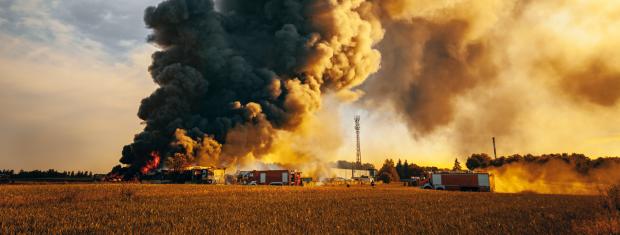
Barn Fires: 5 Safety Considerations
Barn fires are often one of the most tragic losses a farmowner could experience. Aside from losing valuable equipment and the building itself, barn fires typically result in loss of human life and animals as well. Statistics show that summer and winter are the most common times of year for barn fires, so prior to these seasons it’s best for farmowners to take special care and take these items into consideration:
1.Highly Flammable or Combustible Materials
One of the key elements of barn fires are combustible materials. If at all possible, hay, straw and other types of bedding shouldn’t be stored in the same building in which livestock is housed. These materials also shouldn’t be stored with machinery or near any type of electrical or heat source.
Highly flammable materials can include:
- Hay and Straw
- Bedding materials, especially sawdust and shredded newspaper
- Cobwebs, dust and grain dust
- Horse blankets
- Paint
- Fertilizers
- Pesticides and herbicides
2. Accelerants
Accelerants are substances that cause a fire to spread more quickly. While all accelerants are highly combustible and flammable, not all combustible or flammable materials are accelerants. Common accelerants include:
- Gasoline
- Kerosene
- Oil
- Aerosol Cans
- Paint thinner
- Charcoal lighter fluid
All accelerants must be stored in approved containers and properly labeled as such. Maintaining an updated list of all chemicals on the farm is one of the best ways to ensure they are being handled and stored safely. Your list should include the name of the chemical, the quantity of the chemical, date purchased, and its location on the farm. Keep your list somewhere safe and easily accessible.
Some municipalities and states require an accurate inventory and location description be kept on file for all accelerants on the farm to aid the fire department in knowing what potential toxic fumes or explosions may result and how most effectively to contain the situation.
3. Ignition Sources
Anything that can cause an accelerant or flammable material to ignite or smolder is an ignition source. Possible ignition sources include:
- Cigarettes and matches
- Sparks from welding machines and machinery (trucks, tractors, mowers)
- Motors
- Heaters
- Electrical appliances
- Fence chargers
- Electrical fixtures and wires
- Batteries
- Chemicals which may react with each other or with water/dampness
4. Roadways and Farm Access
Should a barn fire occur, it’s important for there to be a direct, unobstructed path for the fire department to access the property as quickly as possible. Minutes can make all of the difference in saving your barn, your belongings, and your livestock.
- Trim back low-hanging tree branches and shrubs
- Overhead wires should hang high enough for vehicles and equipment to pass under
- There should be 20-feet wide fire/emergency lanes around all buildings and structures
- Vehicles of workers and residents should be parked in designated areas to keep roadways open for emergency vehicles
- Prohibit any parking, including trailers, directly next to a barn/stable
- Enforce and post speed limit signs of 15 mph or lower surrounding the barn
5. Barn Construction
Many township’s and building codes require a certain level of precautions be taken to reduce the chance of barn fires. One very effective precaution involves using flame resistant materials and best practices during the construction of a new building.
Be sure to check with the town building inspectors office for the requirements and permits necessary in your area, but consider including some of these extra measures during building construction to keep your barn safe:
- Install approved fire doors
- Ensure a fire wall is installed between hay/bedding storage and the actual stabling area
- Limit the number of stalls in a center aisle barn between entrances and exits, or consider adding an additional exit midway down the rows of stalls
- Utilize flame resistant or flame-retardant materials during construction
- Apply fire retardant latex paint, preferably two coats, on all interior walls
- Install smoke detectors, fire alarms, and sprinkler systems that can be monitored by local police or fire departments
- Presence of a water source on the property, especially a pond, to aid the fire department in saving buildings. Trucking water from a distance if a water hydrant is unavailable can cost precious time in extinguishing a barn fire.
There are many factors to consider when it comes to barn fires. We hope the above considerations help you become more aware of the potential fire hazards present on your farm and outbuildings. Visit our On the Farm blog section for more farmowners tips!


